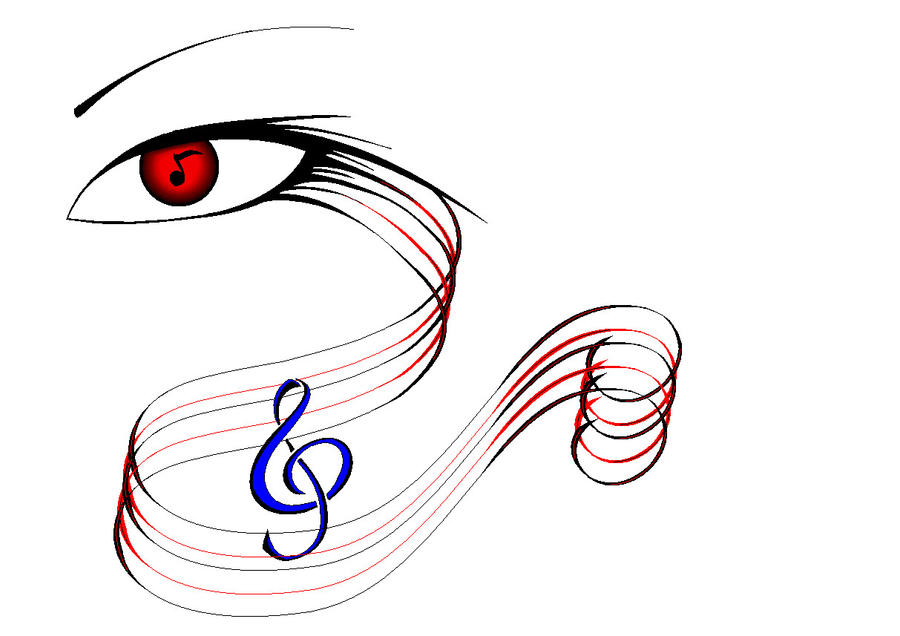Eye music
As eyes music is called all-optical phenomena in the score of a composition that carry symbolic meaning.
Distinction between
In many cases can be distinguished only with difficulty between eyes music and word painting. Word-painting is often both visually and acoustically detectable, eye music, however, is only the eye immediately accessible. As a typical example of word-painting can "fall", a descending melody on the word or use an ascending melody on the word " resurrection ", that's something that belongs equally as can be seen. In contrast, a typical example of music for the eyes would be the use of black note heads on the words " night ", " dark " or "death": something that does not belong, but can only be seen. Eye music is more abstract and context- dependent than word-painting. A love song is not so quoted in heart shape, because the word " heart " actually appears in the text, but because the heart is a symbol of love in our culture. In contrast, word-painting always refers to the specific words appear in the text and is context- independent: melodic wave motion on the text " the surging sea " can understand every person, no matter what culture he belongs. They describe only the specific word with musical tones. It can be found in the score that are not to be regarded as music for the eyes also examples of optical conditions. Thus, the complex cross- rhythms of the English virginalists are indeed intended more for the eye than for the ear, but have little or no symbolic meaning. Asides for the artist, as they occur in scores of Eric Satie, for example, are no more music for the eyes as it does not use the vocabulary of musical signs.
History
The heart-shaped listing of a rondeau of French composer Baude Cordier at the beginning of the 15th century is one of the earliest surviving examples of eye music. Since it is a love song, the heart shape carries symbolic meaning. In the Franco- Flemish composer of the early Renaissance there is also music for the eyes. The most famous composer of this age is Josquin Desprez. His Lamentatio absolve the death of the composer Ockeghem, nymphes des bois, as well as the motet, quaesumus, domine, which was dedicated to the late composer Jacob Obrecht, and Josquin also attributed Proch dolor come down to us only in black notation. The color black refers to a reality outside the text: without the word black is included in the text, in the context of the Christian faith understanding, the black color is identified with the concept of death. Similarly, won at the Franco- Flemish composer the number of votes symbolic meaning. The number seven in the Bible often for Schiv'a, the seven-day mourning period. So Joseph held for his father a seven-day funeral (Gen 50,10 EU), the house of Israel mourns seven days to Judit ( Jdt 16,24 EU). Seven voices as a sign of mourning can be found for example in the aforementioned Proch dolor Josquin and the Nänie for Kaiser Vaet of Jacob Regnart. Another example of symbolic significance in the number of voices are often seven -part compositions of the Seven Sorrows of Mary.
More often, there is music for the eyes in the Italian madrigal the middle and late Renaissance composers such as Adrian Willaert, Palestrina, Giaches de Wert, Giovanni Gabrieli and Marenzio have them readily and frequently used, whereas Cipriano de Rore and Orlando di Lasso, you were critical.
In the Baroque period there are prominent examples, among others, Johann Sebastian Bach and Georg Philipp Telemann. JS Bach: I want the cross -staff gladly carry (excerpt from the cantata of the same name ). The cross sign, which Bach used almost always stereotypically as soon as the text appears the word cross, are an example of eyes music in the Baroque era
Criticism
Music for the Eye is regarded as a musical marginal and mannerism. Great use them only found in the madrigal in Italy. Vincenzo Galilei takes its dialogo della musica antica et della moderna of 1581 critical attitude towards it by calling it a mere pleasure for the eyes ( ... il diletto che da essi si trae, tutto è della vista ). Alfred Einstein referred to in his work, The italian madrigal as the most exaggerated and cruel ( for our aesthetic sensibilities ) Certificate of naturalism, the imitazione, Madrigal ( the most extreme and ( for our aestethic convictions ) most horrible testimony of naturalism, of imitazione, in the madrigal ). In the eyes of music of the 16th century, he sees an early, childish state of aesthetic development. Eye music in the Renaissance Madrigal was determined for the singers and performers, not by the audience, who could not quantify this phenomenon, because they did not present the musical text. The purpose of the music for the eyes was thus in large part in guiding the performers, the mood of the song in mind and to support them in this way in their interpretation.










